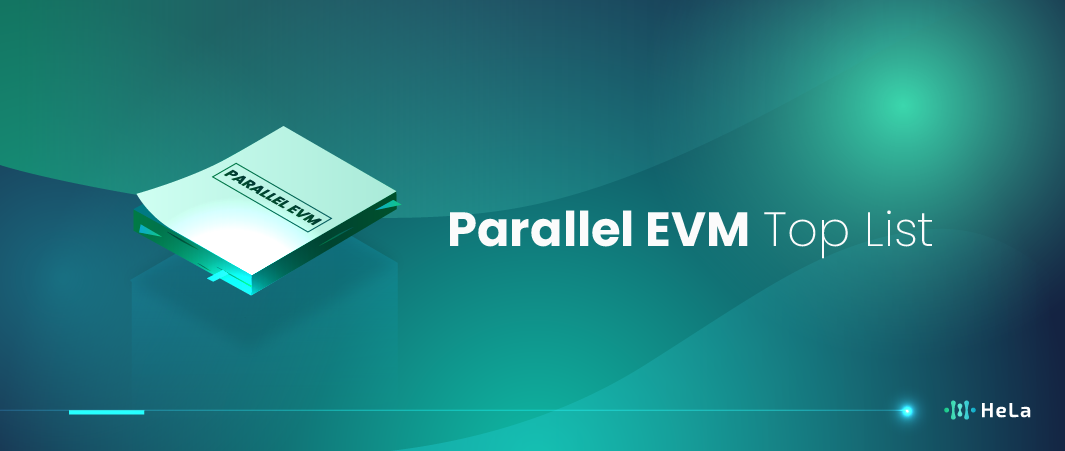As blockchain technology advances, the demand for scalable and high-performance smart contract platforms continues to grow. One of the most promising innovations in this space is Parallel EVM (Ethereum Virtual Machine), which enhances blockchain efficiency by enabling parallel processing of transactions instead of executing them sequentially. This breakthrough significantly improves speed, scalability, and cost-efficiency, making Parallel EVM solutions an essential component for the future of decentralized applications (dApps), DeFi, and Web3 ecosystems.
In this article, we’ll explore 7 of the best list Parallel EVM platforms to consider in 2025. Whether you’re a developer looking for a high-speed execution environment, an investor seeking promising blockchain infrastructure, or a Web3 enthusiast eager to understand the latest innovations, these Parallel EVM solutions are set to revolutionize the way smart contracts and decentralized applications operate.
The Role of Parallel EVMs in Decentralized Finance (DeFi)
Parallel EVMs (Ethereum Virtual Machines) have emerged as a promising solution to address scalability and performance issues in the world of decentralized finance (DeFi). To understand their role and impact, it’s important to first grasp some key concepts in the DeFi space, including smart contracts and decentralized applications (DApps).
Smart Contracts
Smart contracts are self-executing contracts with predefined rules and conditions encoded into computer programs. They run on blockchain networks like Ethereum and facilitate automated and trustless transactions without the need for intermediaries. Smart contracts enable various DeFi applications, such as lending, borrowing, decentralized exchanges, yield farming, and more. They operate according to the logic defined in their code and execute actions based on input data and triggers.
Also Read: Modular Blockchain: Key Advantages, Trends and Predictions
Decentralized Applications (DApps)
Decentralized applications, or DApps, are applications built on blockchain technology. They often rely on smart contracts as their underlying code to provide decentralized and transparent functionality. DApps are designed to eliminate central points of control, enhancing security and reducing the risk of censorship or manipulation. Popular DeFi DApps include Uniswap (a decentralized exchange), Aave (a lending and borrowing platform), and Compound (a protocol for earning interest on cryptocurrency assets).
Parallel EVMs play a crucial role in enhancing the DeFi sector in the following ways:
Scalability
One of the major challenges facing Ethereum, the leading DeFi platform, is scalability. Ethereum’s mainnet has faced congestion and high gas fees due to its limited processing capacity. Parallel EVMs address this issue by allowing multiple virtual machines to operate concurrently, increasing the throughput and capacity of the network. This scalability boost results in faster transaction processing and reduced fees, making DeFi more accessible to a broader user base.
Improved Performance
Parallel EVMs enable DeFi applications to handle a significantly higher volume of transactions and smart contract executions simultaneously. This enhanced performance translates to a smoother user experience, quicker transaction confirmations, and reduced latency. Users can interact with DeFi protocols without encountering delays or high gas costs, which were common issues on Ethereum’s congested network.
Enhanced Security
Security is paramount in the DeFi space, given the value of assets involved. Parallel EVMs can contribute to improved security by reducing the risk of network congestion and potential vulnerabilities that may arise during high-traffic periods. By distributing the workload across multiple virtual machines, they make it more challenging for malicious actors to exploit weaknesses in the network.
Increased Innovation
Parallel EVMs open the door to more innovative DeFi solutions and applications. Developers can build complex, high-performance DApps that were previously hindered by Ethereum’s scalability limitations. This fosters competition and drives innovation, resulting in a wider range of DeFi products and services for users to choose from.
Parallel EVMs have the potential to significantly influence the DeFi sector by addressing scalability issues, improving performance, enhancing security, and fostering innovation. As blockchain technology continues to evolve, these parallel processing solutions will play a pivotal role in shaping the future of decentralized finance.
7 Best List Parallel EVM to Consider in 2025

In 2024, the realm of parallel Ethereum Virtual Machines (EVMs) saw significant advancements, with a few standout projects leading the way. Here’s a list of the top parallel EVMs to watch, each offering unique features and contributions to the blockchain ecosystem:
1. HeLa
HeLa stands out in the parallel EVM space. Hela is a modular Layer-1 blockchain solution designed for real-world adoption. It features EVM compatibility, enabling easy integration and migration of applications. Its modular design allows for scalability and customization in different layers, including consensus, execution, asset integration, and storage.
HeLa prioritizes security and has a sophisticated Decentralized Digital Identity (DID) management system. It utilizes a stablecoin for gas fees, ensuring stable and low transaction costs. These features make Hela a flexible, scalable, and secure blockchain platform.
2. Sei Network
Sei Network is a pioneer in the parallel EVM domain, known for its high throughput and efficient scaling. It uses parallel computing to address blockchain bottlenecks, significantly boosting transaction processing speed. Sei’s architecture diverges from traditional sequential EVMs by processing multiple transactions concurrently. This approach not only enhances scalability but also optimizes computational resources. Additionally, Sei Network employs a twin-turbo consensus mechanism, which includes a two-phase process for quick transaction ordering and final consensus, further enhancing efficiency.
3. Neon Labs
Neon Labs focuses on developing the Neon EVM, a bridge between EVM (Ethereum Virtual Machine) and the Solana blockchain. The company aims to enhance Web3 transactions, making them faster and more affordable. As a remote-first organization, Neon Labs invites collaboration from diverse locations to contribute to this technological advancement. They emphasize their role in driving innovation within the blockchain space, particularly in making Web3 transactions more efficient.
4. Monad.xyz
Monad is another notable project in the parallel EVM landscape, attracting attention for its potential contributions to blockchain scalability and efficiency. Like other parallel EVMs, Monad is likely focused on enhancing transaction throughput and improving the overall performance of blockchain systems.
5. Shardeum
Shardeum focuses on smart sharding to enhance efficiency, directing transactions to specific validators. It has demonstrated remarkable scalability, as evidenced by handling over 1.5 million transactions and 45,000 smart contracts. Shardeum’s ability to support a large number of validators and transactions, especially in use cases like Automated Market Makers, makes it a notable project in the parallel EVM space.
6. Velas
Known for its capability of handling over 75,000 transactions per second (TPS) while maintaining minimal transaction costs, Velas employs an AI-powered Delegated Proof-of-Stake consensus mechanism. This not only improves scalability and security but also ensures optimal interoperability. Velas’ environment is conducive for developers to migrate applications from Ethereum and other EVM-compatible chains, leveraging its high throughput and low cost.
7. BNB Chain’s Parallel EVM 2.0
BNB Chain has implemented advanced features in its Parallel EVM 2.0, such as universal unconfirmed state access, a conflict detector, and efficient memory management. These features aim to optimize parallel transaction execution, ensuring more reliable and efficient blockchain operations. BNB Chain’s approach to parallel EVM technology is instrumental in reducing transaction processing times and costs, thereby enhancing the overall blockchain experience.
Each of these projects contributes to the evolving narrative of parallelized EVMs. By enabling parallel transaction execution, they address critical challenges in blockchain technology, such as scalability, efficiency, and high transaction fees. These advancements are not only significant for Ethereum but also extend to other blockchain platforms, improving the landscape for decentralized applications across various sectors.
The ongoing development and adoption of parallel EVMs are crucial for the future of blockchain technology, offering a more scalable, efficient, and user-friendly ecosystem. As the technology matures, we can expect these and other emerging projects to continue pushing the boundaries of what’s possible in blockchain scalability and efficiency.
Innovations in Scalability and Efficiency

In recent years, the blockchain industry has been increasingly focused on addressing the scalability and efficiency challenges that have hindered the widespread adoption of blockchain technology. One of the key technological advancements in this regard is the development of Parallel EVMs (Ethereum Virtual Machines), which have significantly improved the performance and usability of blockchain networks.
Parallel EVMs refer to a set of techniques and technologies designed to enhance the capabilities of Ethereum and other blockchain platforms, making them more scalable and efficient. These innovations primarily revolve around two key areas:
- Parallel Processing: Traditional Ethereum operates on a single-threaded model, meaning that it processes transactions sequentially, one after the other. This has been a major bottleneck in terms of scalability. Parallel EVMs introduce the concept of concurrent processing, where multiple transactions can be executed simultaneously, greatly increasing the transaction throughput of the network. This parallelism is achieved through the use of sharding, layer 2 solutions, and other techniques that divide the workload among different nodes or chains.
- Gas Optimization: Gas fees have been a major concern for users of blockchain networks. Parallel EVMs incorporate various optimizations in the gas fee calculation and execution process. For instance, they may reduce the computational complexity of smart contracts, optimize the storage of transaction data, and introduce more efficient consensus mechanisms. These improvements result in lower gas fees for users, making blockchain technology more affordable and accessible.
The benefits of these innovations in scalability and efficiency are manifold:
- Increased Throughput: Parallel EVMs can handle a significantly higher number of transactions per second (TPS) compared to the traditional EVM. This is crucial for blockchain networks to accommodate a growing user base and a wider range of use cases, including DeFi (Decentralized Finance) and NFT (Non-Fungible Token) applications.
- Lower Transaction Costs: Reduced gas fees make blockchain usage more cost-effective for both developers and users. This is particularly important for microtransactions and for ensuring that blockchain technology remains accessible to individuals and businesses of all sizes.
- Enhanced User Experience: With faster transaction confirmations and lower costs, users experience a smoother and more efficient blockchain experience. This encourages broader adoption and usage of blockchain applications.
- Improved Developer Ecosystem: Parallel EVMs offer developers greater flexibility and efficiency in building decentralized applications (dApps). Developers can create more complex and resource-intensive smart contracts without worrying about prohibitive gas costs, fostering innovation in the blockchain space.
Security Challenges and Solutions
Parallel EVMs (Parallel Ethereum Virtual Machines) have emerged as a groundbreaking solution to address the scalability limitations of the Ethereum blockchain. However, like any technological advancement, they come with their own set of security challenges. In this discussion, we will delve into these challenges, common vulnerabilities, and attack vectors associated with Parallel EVMs, as well as the innovative security measures and protocols being implemented to mitigate these risks.
Security Challenges
- Interoperability Issues: One of the primary challenges is ensuring the seamless interaction between the main Ethereum network and Parallel EVMs. The risk of incompatibility and data inconsistencies can arise, making it necessary to establish robust bridges and smart contracts for cross-chain communication.
- Consensus Mechanisms: Parallel EVMs may employ different consensus mechanisms, and each of these mechanisms has its own set of security considerations. For instance, proof-of-stake systems may face risks related to stake centralization, while proof-of-authority may have concerns about the integrity of authorized nodes.
- Data Availability: Ensuring the availability of data across parallel chains is vital. Data can become fragmented or inaccessible, leading to potential vulnerabilities and malicious exploits if not managed properly.
Common Vulnerabilities and Attack Vectors
- Reentrancy Attacks: Just as in the main Ethereum network, smart contracts within Parallel EVMs are susceptible to reentrancy attacks, where malicious contracts exploit vulnerabilities in other contracts to drain funds.
- Cross-Chain Attacks: Attackers may exploit the bridges connecting parallel chains to execute cross-chain attacks, potentially compromising the security of both the main chain and the parallel chains.
- Consensus Manipulation: Attackers may attempt to manipulate the consensus mechanisms in parallel chains to control or disrupt the network’s operation, leading to double-spending or other malicious actions.
Innovative Security Measures and Protocols
- Bridge Security: Top Parallel EVMs are implementing advanced bridge security protocols to ensure the safe transfer of assets and data between the main chain and parallel chains. Techniques such as threshold signatures and multi-signature schemes are being utilized to safeguard against unauthorized transactions.
- Cross-Chain Verification: Solutions like cross-chain oracles and cryptographic proofs are being used to verify and validate data across parallel chains, enhancing data integrity and preventing data manipulation.
- Consensus Algorithms: Implementing robust and secure consensus algorithms is crucial. Many Parallel EVMs are exploring hybrid or improved consensus mechanisms that combine the strengths of various protocols while mitigating their respective weaknesses.
- Smart Contract Auditing: Regular smart contract audits and formal verification processes are being employed to identify and fix vulnerabilities before deployment, reducing the risk of smart contract exploits.
- Decentralized Security: Some Parallel EVMs are adopting decentralized governance and security models, empowering the community to actively participate in decision-making and security measures.
The Future of Blockchain with Parallel EVMs

Parallel Ethereum Virtual Machines (EVMs) represent a promising advancement in the blockchain space, poised to revolutionize a wide range of industries, including finance, supply chain management, and many others. This emerging technology has the potential to address some of the key limitations that have hindered the broader adoption of blockchain technology. In this discussion, we will explore the exciting developments in Parallel EVMs and their transformative impact on various sectors.
Enhanced Scalability
One of the most significant challenges facing blockchain networks like Ethereum is scalability. Parallel EVMs offer a solution by allowing multiple virtual machines to run in parallel, significantly increasing the transaction processing capacity. This improvement could pave the way for blockchain networks to handle the high transaction volumes required for mainstream financial applications, such as global payment systems and decentralized exchanges.
Improved Performance
Parallel EVMs can deliver improved performance by distributing the computational load across multiple virtual machines. This means faster transaction confirmation times and reduced congestion during peak network usage. Such improvements are crucial for industries where real-time transactions and responsiveness are paramount, like supply chain management and logistics.
Interoperability
Parallel EVMs can potentially enhance blockchain interoperability. They allow for different blockchains to run side by side, facilitating cross-chain communication and collaboration. This capability is vital for industries that require seamless integration of blockchain solutions into their existing systems, such as healthcare and identity verification.
Energy Efficiency
Many blockchain networks have faced criticism for their energy-intensive consensus mechanisms. Parallel EVMs can help mitigate this issue by optimizing resource allocation, making blockchain networks more energy-efficient. Industries concerned about the environmental impact, like renewable energy trading and carbon credits, could greatly benefit from this advancement.
Enhanced Security
Parallel EVMs can also bolster security by isolating and compartmentalizing smart contracts and decentralized applications (DApps). This reduces the risk of a single vulnerability compromising the entire network. Enhanced security measures are essential for sectors like voting systems and intellectual property rights protection.
Global Adoption
The developments in Parallel EVMs could be the catalyst for broader blockchain adoption across the globe. As blockchain networks become more scalable, efficient, and secure, they become more attractive to governments, enterprises, and individuals. This could result in increased use cases across various sectors, from finance to healthcare to supply chain management.
Also Read: What Is POAP? Significance in Blockchain and Beyond
Innovation Ecosystem
The emergence of Parallel EVMs is likely to foster an innovation ecosystem around blockchain technology. Developers will have more freedom to experiment and create novel DApps and solutions, leading to a vibrant blockchain innovation landscape.
Regulatory Considerations
As blockchain technology matures and becomes more prevalent, regulators will need to adapt to these advancements. Parallel EVMs may prompt governments to develop clearer and more supportive regulations to encourage responsible blockchain usage.
Conclusion
In conclusion, Parallel EVMs stand as a pivotal element in the ever-evolving blockchain ecosystem. Their significance cannot be overstated, as they address some of the most pressing challenges in the field, including scalability, security, and innovation. As we gaze into the future of blockchain technology in 2025, it is clear that these EVMs are well-positioned to lead the charge in driving advancements across these critical fronts. They hold the promise of transforming the way we perceive and utilize blockchain, making it more accessible and efficient than ever before.
Blockchain technology is incredibly dynamic, and the landscape can shift rapidly. By staying informed and engaged, you can ensure that you remain at the forefront of these transformative changes. Explore the various platforms, track their progress, and consider how they might impact your projects or investments. The future of blockchain is filled with possibilities, and Parallel EVMs are an integral part of this exciting journey.
Disclaimer: The information provided by HeLa Labs in this article is intended for general informational purposes and does not reflect the company’s opinion. It is not intended as investment advice or recommendations. Readers are strongly advised to conduct their own thorough research and consult with a qualified financial advisor before making any financial decisions.

Joshua Soriano
I am a writer specializing in decentralized systems, digital assets, and Web3 innovation. I develop research-driven explainers, case studies, and thought leadership that connect blockchain infrastructure, smart contract design, and tokenization models to real-world outcomes.
My work focuses on translating complex technical concepts into clear, actionable narratives for builders, businesses, and investors, highlighting transparency, security, and operational efficiency. Each piece blends primary-source research, protocol documentation, and practitioner insights to surface what matters for adoption and risk reduction, helping teams make informed decisions with precise, accessible content.
- Joshua Soriano#molongui-disabled-link
- Joshua Soriano#molongui-disabled-link
- Joshua Soriano#molongui-disabled-link
- Joshua Soriano#molongui-disabled-link

